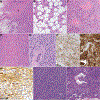Head and Neck Mesenchymal Tumors with Kinase Fusions: A Report of 15 Cases With Emphasis on Wide Anatomic Distribution and Diverse Histologic Appearance
- PMID: 36638315
- PMCID: PMC9846578
- DOI: 10.1097/PAS.0000000000001982
Head and Neck Mesenchymal Tumors with Kinase Fusions: A Report of 15 Cases With Emphasis on Wide Anatomic Distribution and Diverse Histologic Appearance
Abstract
Mesenchymal tumors harboring various kinase fusions were recently recognized as emerging entities mainly in the soft tissues. We herein investigate the clinicopathologic and molecular characteristics of head and neck mesenchymal tumors harboring kinase fusions. The study cohort included 15 patients with a median age of 13 years (ranging from congenital to 63 y). The kinase genes involved in descending order were NTRK1 (n=6), NTRK3 (n=5), BRAF (n=2), and 1 each with MET, and RET. The anatomic locations were broad involving all tissue planes, including skin (n=4), intraosseous (n=4), major salivary glands (n=2), sinonasal tract (n=2), soft tissue of face or neck (n=2), and oral cavity (n=1). The histologic spectrum ranged from benign to high grade, in descending order including tumors resembling malignant peripheral nerve sheath tumor (MPNST)-like, fibrosarcoma (infantile or adult-type), lipofibromatosis-like neural tumor (LPFNT), inflammatory myofibroblastic tumor-like, and a novel phenotype resembling myxoma. Perivascular hyalinization/stromal keloid-like collagen bands and staghorn vasculature were common features in MPNST-like and LPFNT-like tumors. Two tumors (1 each with NTRK1 or BRAF rearrangement) were classified as high grade. By immunohistochemistry, S100 and CD34 positivity was noted in 71% and 60%, frequently in MPNST-like and LPFNT-like phenotypes. Pan-TRK was a sensitive marker for NTRK-translocated tumors but was negative in tumor with other kinase fusions. One patient with a high-grade tumor developed distant metastasis. Molecular testing for various kinase fusions should be considered for S100+/CD34+ spindle cell neoplasms with perivascular hyalinization and staghorn vessels, as pan-TRK positivity is seen only in NTRK fusions.
Copyright © 2022 Wolters Kluwer Health, Inc. All rights reserved.
Conflict of interest statement
Conflicts of Interest and Source of Funding: Supported in part by the Cancer Center Support Grant of the National Institutes of Health/National Cancer Institute under award number P30 CA008748 (B.X., N.P.A., C.R.A.) and P50 CA217694 (C.R.A.). The authors have disclosed that they have no significant relationships with, or financial interest in, any commercial companies pertaining to this article
Figures



Similar articles
-
Kinase fusion positive intra-osseous spindle cell tumors: A series of eight cases with review of the literature.Genes Chromosomes Cancer. 2024 Jan;63(1):e23205. doi: 10.1002/gcc.23205. Epub 2023 Oct 2. Genes Chromosomes Cancer. 2024. PMID: 37782551 Free PMC article. Review.
-
Soft tissue tumors characterized by a wide spectrum of kinase fusions share a lipofibromatosis-like neural tumor pattern.Genes Chromosomes Cancer. 2020 Oct;59(10):575-583. doi: 10.1002/gcc.22877. Epub 2020 Jul 6. Genes Chromosomes Cancer. 2020. PMID: 32506523 Free PMC article.
-
NTRK Fusions Define a Novel Uterine Sarcoma Subtype With Features of Fibrosarcoma.Am J Surg Pathol. 2018 Jun;42(6):791-798. doi: 10.1097/PAS.0000000000001055. Am J Surg Pathol. 2018. PMID: 29553955 Free PMC article.
-
Mesenchymal tumors of the gastrointestinal tract with NTRK rearrangements: a clinicopathological, immunophenotypic, and molecular study of eight cases, emphasizing their distinction from gastrointestinal stromal tumor (GIST).Mod Pathol. 2021 Jan;34(1):95-103. doi: 10.1038/s41379-020-0623-z. Epub 2020 Jul 15. Mod Pathol. 2021. PMID: 32669612
-
A novel group of spindle cell tumors defined by S100 and CD34 co-expression shows recurrent fusions involving RAF1, BRAF, and NTRK1/2 genes.Genes Chromosomes Cancer. 2018 Dec;57(12):611-621. doi: 10.1002/gcc.22671. Epub 2018 Oct 1. Genes Chromosomes Cancer. 2018. PMID: 30276917 Free PMC article.
Cited by
-
Molecular pathology in diagnosis and prognostication of head and neck tumors.Virchows Arch. 2024 Feb;484(2):215-231. doi: 10.1007/s00428-023-03731-2. Epub 2024 Jan 13. Virchows Arch. 2024. PMID: 38217715 Free PMC article. Review.
-
NTRK Therapy among Different Types of Cancers, Review and Future Perspectives.Int J Mol Sci. 2024 Feb 17;25(4):2366. doi: 10.3390/ijms25042366. Int J Mol Sci. 2024. PMID: 38397049 Free PMC article. Review.
-
Kinase fusion positive intra-osseous spindle cell tumors: A series of eight cases with review of the literature.Genes Chromosomes Cancer. 2024 Jan;63(1):e23205. doi: 10.1002/gcc.23205. Epub 2023 Oct 2. Genes Chromosomes Cancer. 2024. PMID: 37782551 Free PMC article. Review.
-
PDGFRA::USP8 Fusion in a Cutaneous Inflammatory Myofibroblastic Tumor, Highlighting Genetic Pleiotropy of Kinase Gene Fusions in Soft Tissue Neoplasms.Genes Chromosomes Cancer. 2025 Feb;64(2):e70035. doi: 10.1002/gcc.70035. Genes Chromosomes Cancer. 2025. PMID: 39950323 Free PMC article.
-
Spindle Cell Tumors of the Sinonasal Tract: A Diagnostic Update with Focus on Ancillary Workup.Head Neck Pathol. 2024 Feb 16;18(1):8. doi: 10.1007/s12105-023-01605-2. Head Neck Pathol. 2024. PMID: 38363429 Free PMC article. Review.
References
-
- Davis JL, Al-Ibraheemi A, Rudzinski ER, et al. Mesenchymal neoplasms with NTRK and other kinase gene alterations. Histopathology. 2022;80:4–18. - PubMed
-
- Knezevich SR, Garnett MJ, Pysher TJ, et al. ETV6-NTRK3 gene fusions and trisomy 11 establish a histogenetic link between mesoblastic nephroma and congenital fibrosarcoma. Cancer Res. 1998;58:5046–5048. - PubMed
Publication types
MeSH terms
Substances
Grants and funding
LinkOut - more resources
Full Text Sources
Medical
Research Materials
Miscellaneous

